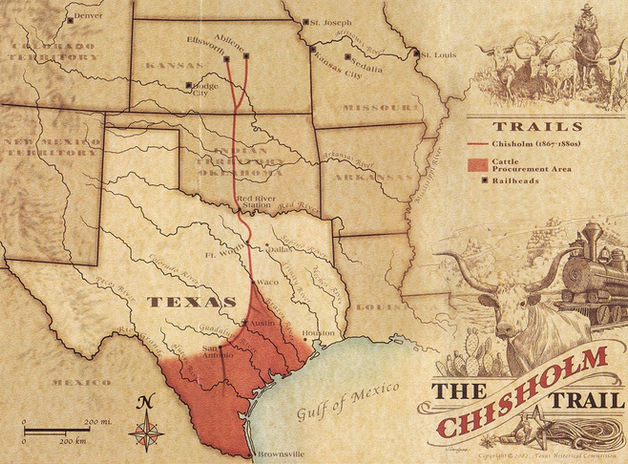
The Chisholm Trail
Kimball Brazos Crossing
The town of Kimball which lies just several miles north of Kopperl on the Brazos was host to one of the largest Brazos River Crossings on the Famous Chisholm Trail. The town of Kimball was founded in 1853 at a strategic point on the Brazos river that offered a perfect place to ford cattle. The gentle sloping hard sand banks were free of quick sand and allowed for a safe crossing. Kimball also offered a ferry service which was helpful.
The Chisholm Trail was the most important route for cattle drives leading north from South Texas, across Indian Territory (Oklahoma) to the railhead at Abilene. It was about 520 miles long and generally followed the line of the ninety-eighth meridian, but never had an exact location, as different drives took somewhat different paths. With six states enacting laws in the first half of 1867 against trailing cattle north, Texas cattlemen realized the need for a new trail that would skirt the farm settlements and thus avoid the trouble over tick fever. In 1867 a young Illinois livestock dealer, Joseph G. McCoy, built market facilities at Abilene, Kansas, at the terminus of Chisholm Trail. The new route to the west of the Shawnee soon began carrying the bulk of the Texas herds, leaving the earlier trail to dwindle for a few years and expire. Although the Chisholm trail ran through present-day Oklahoma, which then was Indian Territory, there were relatively few conflicts with Native Americans, who usually allowed cattle herds to pass through for a toll of ten cents a head.
Later, other trails forked off to different railheads, including those at Dodge City and Wichita, Kansas. By 1877, the largest of the cattle-shipping boom towns, Dodge City, Kansas, shipped out 500,000 head of cattle. The Chisholm Trail was finally closed by barbed wire and an 1885 Kansas quarantine law; by 1884, its last year, it was open only as far as Caldwell, in southern Kansas. In its brief existence it had been followed by more than five million cattle and a million mustangs, the greatest migration of livestock in world history.
Although the Chisolm Trail closed up north, the cattle crossing at Kimball still saw some use until the early 1900s when its last cattle crossing took place. The emergence of the many railways including the Gulf, Colorado & Santa Fe Railway which crossed the river just south of Kimball eventually led to the downfall of the town
Links to Information in regards to the Chisholm Trail








